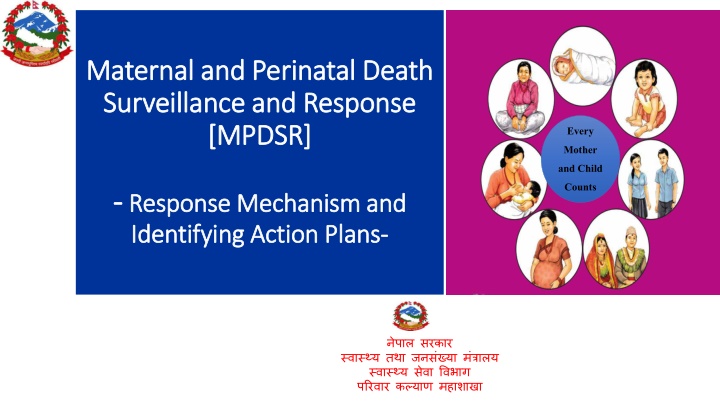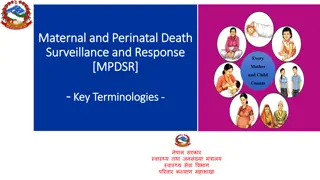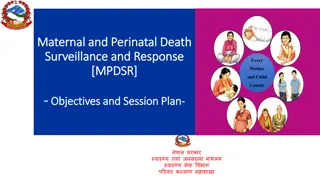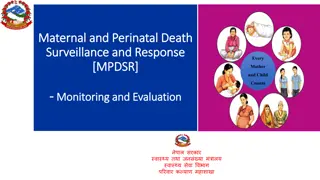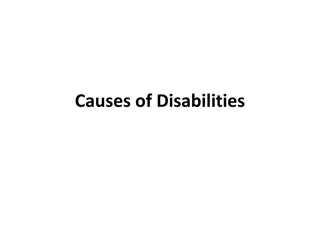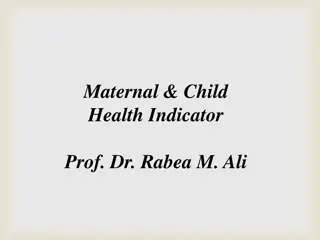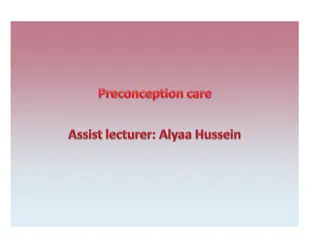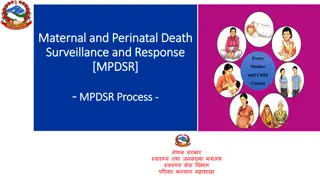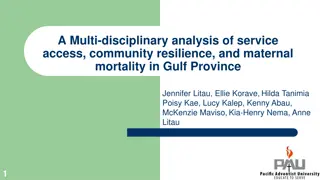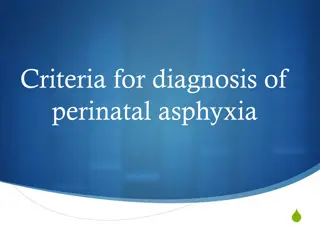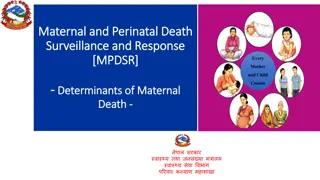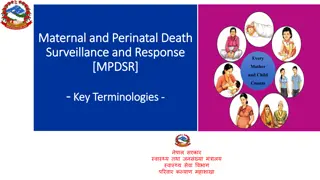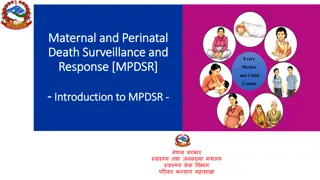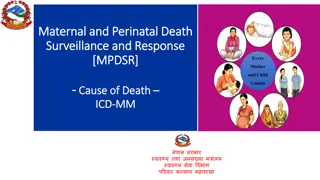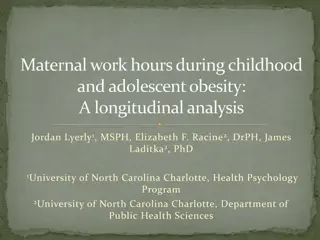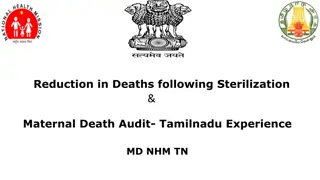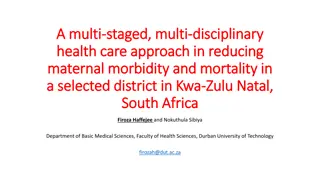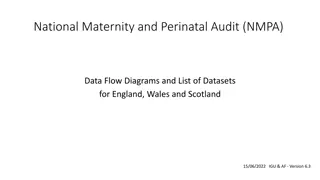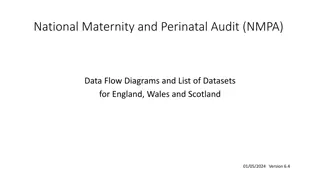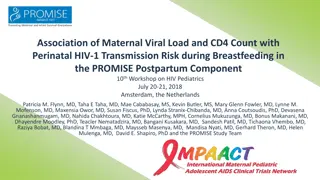Maternal and Perinatal Death Surveillance and Response
This content delves into the process of Maternal and Perinatal Death Surveillance and Response (MPDSR), focusing on identifying avoidable factors, implementing action plans, and formulating evidence-based actions to reduce maternal mortality. It emphasizes the importance of evidence-based practices in managing maternal health, with a spotlight on actions related to eclampsia diagnosis and treatment.
Download Presentation

Please find below an Image/Link to download the presentation.
The content on the website is provided AS IS for your information and personal use only. It may not be sold, licensed, or shared on other websites without obtaining consent from the author.If you encounter any issues during the download, it is possible that the publisher has removed the file from their server.
You are allowed to download the files provided on this website for personal or commercial use, subject to the condition that they are used lawfully. All files are the property of their respective owners.
The content on the website is provided AS IS for your information and personal use only. It may not be sold, licensed, or shared on other websites without obtaining consent from the author.
E N D
Presentation Transcript
Maternal and Perinatal Death Maternal and Perinatal Death Surveillance and Surveillance and Response [MPDSR] [MPDSR] Response Every Mother and Child Counts Counts Every Mother and Child - - Response Mechanism and Response Mechanism and Identifying Action Plans Identifying Action Plans- -
Objectives Objectives By the end of session, the participants will be able to formulate evidence based actions and prioritization based on the information from the filled MDR and PDR forms, and describe how the action plan will be implemented for improving quality of care.
MPDSR: A Continuous Process of Learning MPDSR: A Continuous Process of Learning Information Accountability Maternal death who, where, how, when Actions Policy, strategies, protocols, guidelines, programme, activities, management/administration etc. Cause of Death (MDR + VA) Avoidable factors (HF + Community) Notification MPDR at HF Review Response Surveillance Action Plan Screening Verbal Autopsy Learning Learning Learning Learning Learning Learning Learning Learning
Response Mechanism Response Mechanism Taking action to reduce avoidable maternal deaths is the reason for conducting MPDSR Type of action will depend on the delays or avoidable factors identified during review at hospital level and community level. Action plans should be based on evidence- based actions Need to prioritize the actions which are simple, practical/doable, evidence based and cost effective Link the response to quality of care at the hospital
What are Evidence Based Actions What are Evidence Based Actions Actions for which there is enough evidence that maternal mortality and morbidity will be prevented if they are followed Usually refer to clinical actions, based on trials, researches & standard guideline Individual cases should be reviewed to see if best practices were carried out or not Review should be targeted on identifying which better evidence based action might have been taken to manage the particular case
Evidence Based Actions for Evidence Based Actions for Eclampsia Eclampsia Diagnosis and treatment of high blood pressure Magnesium Sulphate Timely delivery
Evidence Based Actions for Haemorrhage Evidence Based Actions for Haemorrhage Active management for 3rd stage labour Uterotonics (Misoprostol/Oxytocin) Blood transfusion
Evidence Based Actions for Sepsis Evidence Based Actions for Sepsis Aseptic precautions Antibiotics for mother with prolonged rupture of membrane Antibiotics for C/S Avoid prolonged labour
Evidenced Based Actions for Obstructed Evidenced Based Actions for Obstructed Labour Labour Facility delivery Use of Partograph as a decision-making tool Availability of C/S service
Ensuring Responses Mechanism Ensuring Responses Mechanism Use Five WHY method to identify the root cause of the avoidable factor and develop action plan to prevent the avoidable factor. estimate timeline, monitor and timely communication Identify avoidable factors and use evidence- based approach to review Monitor to ensure implementati on of action plans
Example: Five WHY Review method Example: Five WHY Review method MgSO4 not given to patient with eclampsia in ER Not available at Emergency Room Store informed Store locked Store keeper on leave
Example: Five WHY Review method Example: Five WHY Review method MgSO4 not given to patient with eclampsia in ER MgSO4 available but on duty staff not confident Protocol not available
Case Scenario Case Scenario A 20-year old primi gravida with term pregnancy was admitted in hospital in active phase of labour. She had 2 ANC visits in 6 and 8 months at a local HP. She was referred from a birthing center for prolonged labour with no documents. At the hospital, trial for labour was given for 6 hours and decided for cesarean section. The operation got delayed due to unavailability of blood. However, the operation was performed 2 hours later. A fresh still born baby was delivered. Massive hemorrhage occurred during the operation and the woman could not be saved.
Possible Actions Include Possible Actions Include Feedback for timely referral to the referring birthing center Use of partograph / expert consultation for timely decision making Coordination with blood banks for timely availability of blood Increased preparedness for in-referrals and timely out-referrals with life saving arrangements Review and sharing of findings/ results in periodic meetings 14
Community Community- -based actions based actions Changing health seeking behavior Addressing transportation issues Reducing cost of accessing care Identification and prompt referral Raise awareness on safe motherhood programs Mobilize AAMA Samuha to raise awareness and implement preventive programs
The actions are likely to be successful if they are innovative, focused to avoid preventable factors and involve all stakeholders for participation.
Prioritizing Actions Prioritizing Actions When there are many options, how do you pick from among them? Not all problems can be tackled simultaneously Prevalence how common is the problem? Feasibility of carrying out the action Are there extra staff available? Is it technologically and financially possible? What is the potential impact of the action? If successfully implemented how many women would be reached and how many lives saved?
Example of Avoidable Factors Example of Avoidable Factors PATIENT ASSOCIATED Never initiated antenatal care Infrequent visits to antenatal clinic Inappropriate response to rupture of membranes Inappropriate response to antepartum haemorrhage Inappropriate response to poor fetal movements Delay in seeking medical attention during labour Attempted termination of pregnancy Failed to return on prescribed date Declines admission/treatment for personal/social reasons Partner/Family decline admission/treatment
Example of Avoidable Factors Example of Avoidable Factors ADMINISTRATIVE PROBLEMS Lack of transport Home to institution , institution to institution Insufficient blood/blood products available Personnel not sufficiently trained to manage the patient Personnel too junior to manage the patient No dedicated high risk ANC at referral hospital Insufficient nurses on duty to manage the patient adequately Insufficient doctors available to manage the patient Anaesthetic delay No accessible neonatal ICU bed with ventilator Staff rotation Lack of adequate neonatal transport
Example of Avoidable Factors Example of Avoidable Factors MEDICAL PERSONNEL ASSOCIATED Medical personnel underestimated fetal size No response to history of stillbirths, abruption, etc. No response to poor uterine fundal growth No response to maternal hypertension No antenatal response to abnormal fetal lie Poor progress in labour, but partograph not used, Partograph not used correctly, partograph interpreted incorrectly Fetal distress not detected intrapartum Management of 2nd stage: prolonged with no intervention Breech presentation not diagnosed until late in labour
Example of Avoidable Factors Example of Avoidable Factors MEDICAL PERSONNEL ASSOCIATED Delay in medical personnel calling for expert assistance Delay in referring patient for secondary/tertiary treatment No response to apparent post-term pregnancy Neonatal care: inadequate monitoring Neonatal care: management plan inadequate Baby sent home inappropriately No response to history of poor fetal movement Multiple pregnancy not diagnosed intrapartum Physical examination of patient at clinic inappropriate Delay in doctor responding to call
Example of Avoidable Factors Example of Avoidable Factors MEDICAL PERSONNEL ASSOCIATED Nosocomial infection Inadequate/no advice given to mother Antenatal steroids not given Incorrect management of antepartum haemorrhage Incorrect management of premature labour Incorrect management of cord prolapse INSUFFICIENT NOTES TO COMMENT ON AVOIDABLE FACTORS Insufficient notes File missing Antenatal card lost
Implementation of Action Plan Implementation of Action Plan Recommendations made by the different levels MPDSR committees should be carried out at each level of health care provision. This will ultimately lead to actions, which in turn will be responsible for improvement in patient care as well as improvement in health care at the community. The response at different level may be diverse due to authority, resources, capacity of the committees, socio-economic conditions of the community and population coverage.
Implementation of Action Plan Implementation of Action Plan Action plans developed after reviewing of each maternal death should be finalized and shared with the concerned authorities within 1 week. Responsible authority Supportive authority Reporting to be done in web-based system immediately for maternal death and monthly for perinatal death. Monitoring will be done by: PHD HO FWD
Implementation of Action Plan Implementation of Action Plan Responsible authority needs to coordinate and initiate the process of the action plan. Any support needed for implementation of the action plan should be timely communicated. The status of the action plan should be discussed monthly. Challenges while implementing action plans should be documented and communicated. Reporting should also include completed action plans.
Cause of maternal deaths Cause of maternal death in January Cause of maternal death in February Cause of maternal death in March 2 3 4 5 7 8 5 5 8 PPH PPH PPH Pre / Eclampsia Pre / Eclampsia Pre / Eclampsia Pregnancy-related infection Pregnancy-related infection Pregnancy-related infection 26
Cause of maternal deaths Cause of maternal death in April Cause of maternal death in May Cause of maternal death in June 2 4 5 4 4 7 5 4 2 PPH PPH PPH Pre / Eclampsia Pre / Eclampsia Pre / Eclampsia Pregnancy-related infection Pregnancy-related infection Pregnancy-related infection 27
January February March April May June A. Total number of deliveries (including stillbirths) 713 644 589 630 558 540 B. Total number of maternal deaths 15 8 5 2 16 5 8 3 16 4 5 7 14 7 5 2 13 5 4 4 10 4 2 4 C. Deaths due to PPH D. Deaths to PE/E E. Deaths due to pregnancy-related infection H. Proportion of deaths due to PPH (Row C divided by Row B) I. Proportion of deaths due to PE/E (Row D divided by Row B) J. Proportion of deaths due to infection (Row E divided by Row B) 28
January February March April May June A. Total number of deliveries (including stillbirths) 713 644 589 630 558 540 B. Total number of maternal deaths 15 8 5 2 16 5 8 3 16 4 5 7 14 7 5 2 13 5 4 4 10 4 2 4 C. Deaths due to PPH D. Deaths to PE/E E. Deaths due to pregnancy-related infection H. Proportion of deaths due to PPH (Row C divided by Row B) 53% 31% 25% 50% 38% 40% I. Proportion of deaths due to PE/E (Row D divided by Row B) 33% 50% 31% 36% 31% 20% J. Proportion of deaths due to infection (Row E divided by Row B) 13% 19% 44% 14% 31% 40% 29
January to June A. Total number of deliveries (including stillbirths) 3674 B. Total number of maternal deaths 84 33 29 22 C. Deaths due to PPH D. Deaths to PE/E E. Deaths due to pregnancy-related infection H. Proportion of deaths due to PPH (Row C divided by Row B) 39% I. Proportion of deaths due to PE/E (Row D divided by Row B) 35% J. Proportion of deaths due to infection (Row E divided by Row B) 26% 30
First leading cause of death: PPH Second leading cause of death: Pre/eclampsia 31
Actions No uterotonic for prevention and management of PPH in the labour ward Provider did not know how to manage PPH Modifiable factors Actions Ensure availability of oxytocin in the labour ward 24/7 Develop a log to track availability of oxytocin Ensure that providers know how to manage uterine atony and other causes of PPH Ensure that all providers are competent and understand the importance of providing active management of the third stage of labour Introduce a systematic written protocol, with assigned staff, to monitor all women for bleeding and other danger signs after birth 1 2 Immediate postpartum prophylactic uterotonic not administered (active management of the third stage of labour) Woman not monitored for bleeding after delivery 32
Actions Delayed identification of PPH in the postnatal ward No uterotonic available in the postnatal ward Modifiable factors Actions Ensure that providers conduct regular postnatal checks in the postnatal ward Ensure that providers document regular postnatal checks in the client file Ensure availability of oxytocin in the postnatal ward 24/7 Develop a log to track availability of oxytocin Strengthen providers skills to manage atonic uterus and other causes of PPH Ensure the existence of a log/system to monitor and document availability of blood and blood products Introduce team-based PPH simulation drills to strengthen coordination and performance of all relevant staff in an emergency. 3 4 Provider did not know how to manage PPH Lack of blood and/or blood products 33
Prioritising Response What are the most common modifiable factors contributing to PPH that your team should prioritise? Based on these common modifiable factors and the recommended responses, discuss how your committee will prioritise aggregate responses to accelerate the reduction of deaths of women due to PPH in your facility. 34
